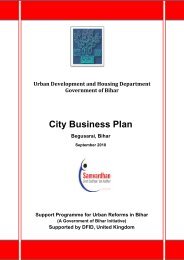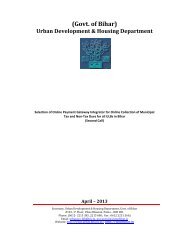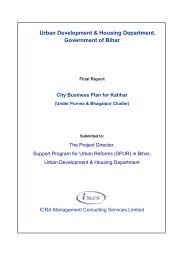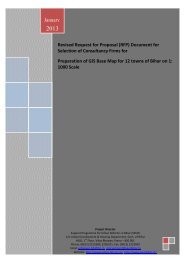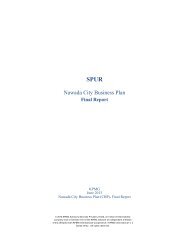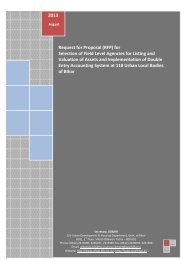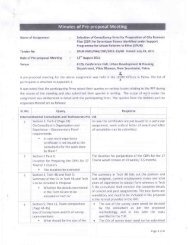CITY BUSINESS PLAN
CITY BUSINESS PLAN
CITY BUSINESS PLAN
You also want an ePaper? Increase the reach of your titles
YUMPU automatically turns print PDFs into web optimized ePapers that Google loves.
City Business Plan for Muzaffarpur Municipal Corporation<br />
Figure 1.1: Stages of CBP<br />
CBP Final Report<br />
Organisation of a Task Force meet to review the<br />
draft CBP report<br />
Preparation of a Final CBP report<br />
Preparation of a city business catalogue<br />
Collection and compilation of data from the<br />
ULB, DIC, BIADA, Chamber of Commerce,<br />
Agriculture Department etc.<br />
Formation and meeting of a Task Force<br />
chaired by the District Magistrate and<br />
involving related CBP stakeholders for<br />
review of progress and inputs vis-à-vis focus<br />
areas of CBP as well as prioritising valuechains<br />
2 on the basis of comparative advantage<br />
and demand potential beyond limited local<br />
demand as well as workforce participation<br />
Study and compilation of an overview of the<br />
city economy in each of the target cities<br />
Study of economic sectors of each city and its<br />
adjacent regions<br />
Investment climate and business<br />
competitiveness analysis<br />
Study of alignment status with ongoing<br />
Central and State Government programmes<br />
Scrutiny of value chains and existing business<br />
linkages of SMEs and micro enterprises<br />
Scrutiny of circumstance vis-à-vis skill and<br />
entrepreneurship training initiatives<br />
Analysis of municipal approval systems; and<br />
other DIC and BIADA related approval<br />
systems as they apply to manufacturing and<br />
service sector enterprises even within<br />
municipal limits<br />
Study of PPPs in investment opportunities;<br />
study of municipal land as well as BIADA<br />
land as manufacturing and also many service<br />
sector enterprises are located in BIADA<br />
estates; Study of City Development and<br />
Investment Plans<br />
Study of status of vendors<br />
Preparation of the final CBP<br />
incorporating comments from<br />
Client.<br />
Potential assessment and<br />
preparation of draft CBPs<br />
with intervention plan;<br />
preparation of a business<br />
catalogue<br />
Status assessment “As is” of<br />
parameters related to CBPs;<br />
organisation of a Task Force<br />
meeting to review and guide<br />
CBP preparation<br />
Project Initiation<br />
Evolution and preparation of intervention<br />
plan vis-à-vis:<br />
Investment climate and business<br />
competitiveness; and on critical (cluster) 1<br />
value-chain interventions and business<br />
linkages<br />
Scope for alignment with ongoing Central<br />
and State Government programmes and<br />
schemes<br />
Skill and entrepreneur training initiatives<br />
Alignment with city development and<br />
investment study (particularly vis-à-vis<br />
“sectors” such as “Economy, trade and<br />
commerce”)<br />
Recommendations with respect to municipal<br />
(and other related) approval systems<br />
Recommendations upon municipal (and other<br />
related) land auditing<br />
PPPs in investment opportunities<br />
Vendors<br />
analysis<br />
Submission of a Draft Report<br />
Mobilisation and start-up<br />
Meeting with SPUR-DFID and ULB officials;<br />
Conduct of preliminary FGDs with ULB,<br />
Chamber of Commerce, DIC, BIADA,<br />
Polytechnic representatives and NGOs; and<br />
individual consultative meets with<br />
entrepreneurs in manufacturing and service<br />
sectors and traders etc.<br />
Basic identification of information sources in<br />
the light of needs; preparation of information<br />
check-list 3<br />
Literature review 4<br />
Finalisation of approach and methodology<br />
Inception Report Submission<br />
1<br />
Cluster” refers to enterprise clusters of similar type of business activities (SPUR, 2010: City/Municipal business plan framework – Operations Manual, LED). The<br />
Government of India considers clusters as manufacturing and service sector enterprises involved in similar type of activity agglomerated in one location such as a<br />
district or taluka. Critical related and supporting enterprises involved in different value-chain activities are also considered part of a cluster.<br />
2<br />
Value-chains involve stakeholders in manufacturing and service sectors as well as in trading, retail and wholesale activities.<br />
3<br />
Annexure 1.1 presents the same and information was culled on this basis to the extent available/feasible. Annexure 1.2 presents a questionnaire schedule which<br />
served more as a discussion format over FGDs and individual consultations with value-chain stakeholders.<br />
4<br />
City Development Plan; “Understanding the urban street vending sector: A socio economic study across 28 cities in Bihar”, SPUR DFID study, 2010; Bihar Municipal<br />
Act (BMA), 2007; Applicable building bye-laws and zoning regulations; Industrial and investment policy of Bihar; ADB, 2010: “Competitive Cities”, Asian Development<br />
Bank, Manila; M.E. Porter, 1988. “Clusters and the new economics of competition”, Harvard Business Review, Harvard University; SPUR, 2010. “Local Economic<br />
Development”; other relevant documents.<br />
Final Report<br />
1-5




